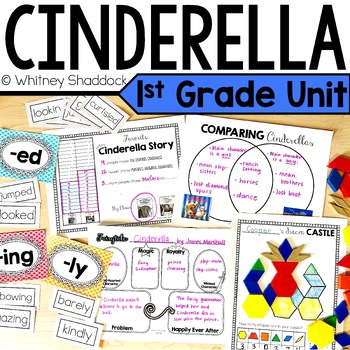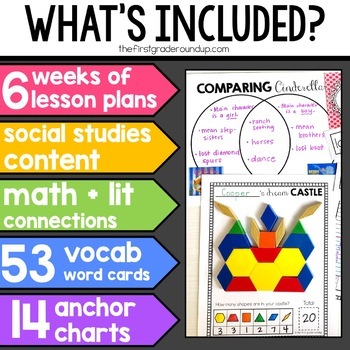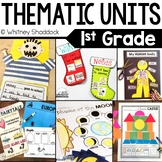Comparing Cinderella Stories Around the World - 1st Grade Fairy tale Unit
- PDF
What educators are saying
Also included in
- Are you struggling to fit science and social studies in your busy first grade schedule? Look no further! These six science and social studies thematic units for 1st grade are planned in detail and ready to use. Each of the 6 first grade units begins with a content big idea and then integrates intoPrice $85.00Original Price $117.55Save $32.55
- Are you struggling to fit 1st grade social studies in your busy schedule? Look no further! These four social studies thematic units for first grade are planned in detail and ready to use. Each of the 4 first grade social studies units begins with a content big idea and then integrates into readingPrice $65.00Original Price $81.85Save $16.85
Description
Comparing Cinderella stories around the world is a great way to teach the elements of fairytales and diverse cultures in first grade. This 6 week integrated fairy tale unit is perfect for integrating social studies and literacy in the first grade classroom.
Are you struggling to fit social studies in your busy first grade schedule? Look no further! This first grade fairytales unit integrates literacy and social studies to make your literacy block more impactful and help you use your precious instructional time wisely.
Beef up your first grade literacy block by integrating social studies to help students understand the big idea, “Different versions of the same story teach us about diverse cultures.”
What is a first grade integrated thematic unit?
An integrated thematic unit combines content and literacy into one common learning theme so that both sets of standards can be covered during the same block of lessons. The units last 5 to 7 weeks and focus mostly on social studies or science and literacy. They do connect to math when it is appropriate, too!
Why should I use thematic units in my first grade classroom?
Let's be honest! We don't have a ton of time for science or social studies in first grade. So when we teach it, we need to be able to get a good bang for our buck. Integrated thematic units save instructional time AND make learning more meaningful for your first graders!
There’s no need to spend your time putting together a cohesive unit and writing lesson plans for your content and literacy. I’ve already done that time consuming work for you! By purchasing this unit, you will have a completely integrated plan for this thematic unit and all the tools you need to teach for 6 weeks!
Literacy topics taught in this first grade Cinderella fairytales unit
- retelling
- elements of fairytales
- comparing and contrasting similar stories
- informative writing
- narrative writing
- opinion writing
- fictional writing
- character traits
- shades of meaning (vocabulary)
- root words
- inflectional endings
- tier 2 vocabulary words
- point of view
- suffixes
- shared research and finding key details
Social Studies topics taught in this first grade Cinderella unit
- 7 continents
- cultures around the world
- mapping skills
- research skills
What You'll Get
- 6 weeks of visual weekly plans for social studies, reading, and writing, plus math and phonics connections
- 18 pages of daily lesson plans already DONE for you! :)
- 62 "I Can" Common Core objective cards
- Daily Messages templates to match unit theme
- Unit display poster with the unit big idea
- 53 vocabulary cards and a blank page for customizing
- fairytale graphic organizer in full color for digital use and BW master for copies
- 7 Continent informative writing passages to use for mini writing lessons (color and BW masters)
- 13 writing prompts (informative, opinion, narrative and fictional writing)
- -own (crown) word family build-write-draw phonics printables
- 6 graphs comparing versions of Cinderella or continents
- cowboy craftivity for the western versions of Cinderella
- character trait maps for Cinderella and the stepmother (color and BW options)
- shades of meaning organizers for describing tier 2 vocabulary words for Cinderella and the stepmother (color and BW options)
- root word activities with inflectional endings (-ing, -ed, -ly). Words are tied from the original European Cinderella vocab words.
- "My dream shape castle" math activity and recording sheets
- writing graphic organizer charts for informative, opinion and narrative writing
- time to the hour and half hour matching game
- 5 Venn Diagrams in color and black and white to compare versions of Cinderella, continents and a blank customizable diagram.
- World map labeling activity
- character trait crown craftivity
- star-star-wish peer review handout
- royal measurement activities with non-standard measurement tools and comparing lengths
- Cinderella root word printables and sorts
- "Sparkle Words" (tier 2 vocabulary word) matching cards and practice page
- 7 continents song and poem handout
- point of view printable
- suffix word sort
- 10 Anchor Charts (Color and BW options and single page and poster size options): Europe, North America, South America, Asia, Australia, Antarctica, Africa, Sparkle (tier 2 vocab) words, things we've lost, elements of fairytales
- fairytale Madlib
- Fairytale Ball Project: details on schedules, checklist of what to do, how to decorate, parent letters, community connections, and pictures of our actual fairytale ball.
Want to see even more details about what is included in this 200+ page unit? Click the preview to get a closer look!
TEACHERS LIKE YOU SAID…
⭐️⭐️⭐️⭐️⭐️ “Great resource. In the "Disney" world, most students don't know there are multiple versions of all fairy tales. Loved this unit as a way to open doors that the students didn't even know existed.” ~Heather
⭐️⭐️⭐️⭐️⭐️ “Five stars isn't enough. This was an excellent and comprehensive unit study. My homeschooled 1st grader loved it.” ~Karen
⭐️⭐️⭐️⭐️⭐️ “This is a great resource. Very complete! I like the way she weaved in non-fairy tales for one section for comparison exercises. Very happy with the purchase.” ~Shannon
⭐️ BUNDLE & SAVE FOR A DISCOUNT ⭐️
Purchase the Year of 1st Grade Thematic Units to get this unit plus 5 more integrated units for science and social studies.
You may also like…
→ Year Long Pacing Guide for 1st Grade
→ First Grade Fables & Economics Unit
Having difficulty with a file?
Visit the FAQs section, submit a help ticket, or ask a question on the Q&A tab before leaving feedback.
___________________________________
Copyright © The First Grade Roundup by Whitney Shaddock.
Permission to copy for single classroom use only.
Please purchase additional licenses if you intend to share this product.
LET'S CONNECT







